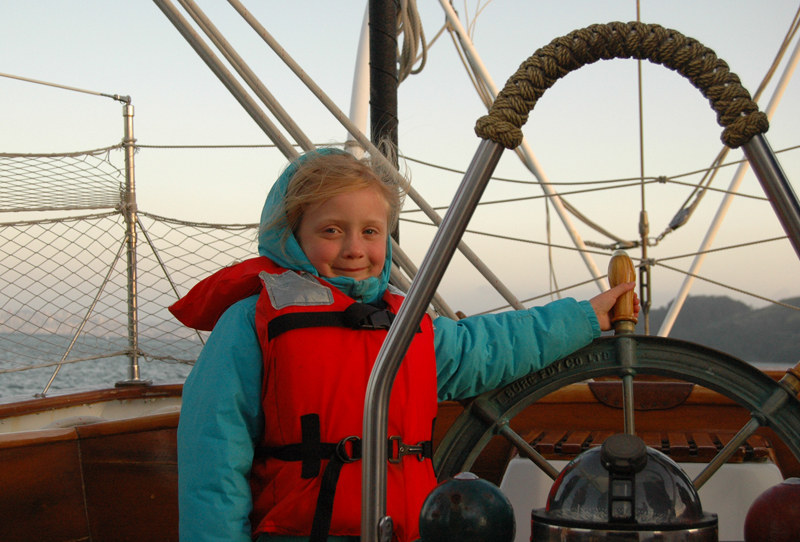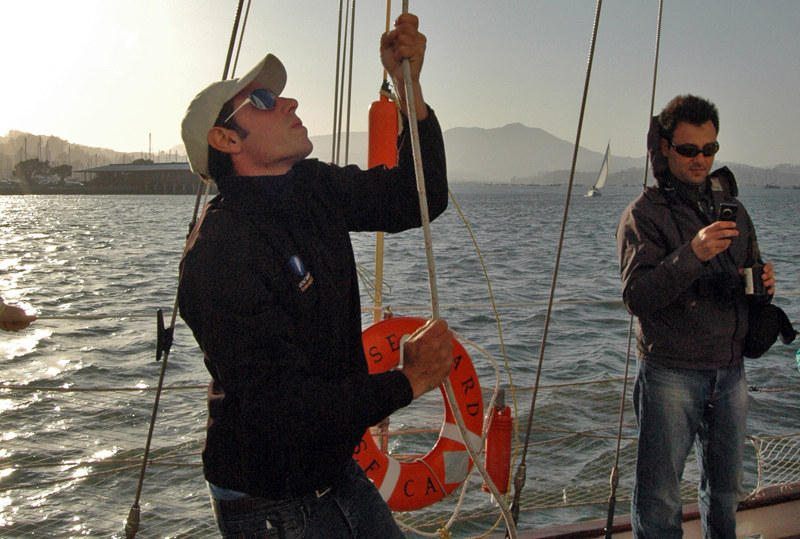
Bay Area Boaters Rescued off Costa Rica

When Stephen Szukics’ dockmates at Loch Lomond Marina in San Rafael heard that the 55-year-old was planning to take his 55-ft wooden Baglietto powerboat Black Pearl to Texas via the Panama Canal, they tried to talk him out of it. The boat had been a liveaboard in the marina for about eight years and needed a lot of work before it could be considered seaworthy. But Szukics seemed unconcerned. One of his neighbors remembers him shrugging off potential dangers, saying "If I die, I die." That’s a hard point to argue.
But we’re guessing James Winningham, Szukics’ crew for the passage south, wasn’t aware of his skipper’s credo. According to dockside scuttlebutt, Winningham, 45, had posted a ‘Want to Crew to Mexico’ flyer at the marina, and didn’t know Szukics or the boat.
"We were really worried about them when they left," said one marina tenant. "He didn’t even know what channel markers were and ran right across the mud." But the pair had clearly figured things out, as they made it as far as Costa Rica in the two months since their inauspicious departure.
But then the boat sank.
According to a Coast Guard press release, the Alameda Rescue Coordination Center received Black Pearl‘s EPIRB signal early Monday morning. Commerical ships in the area couldn’t find any signs of distress so the Coast Guard launched a C130 plane. Following the EPIRB signal, they spotted an Avon inflatable early yesterday morning about 50 miles off the coast of Costa Rica. They dropped food, water and a radio, while the Alameda-based 378-ft cutter Sherman powered to the scene. The weather was calm and the transfer of the two survivors from their leaking and deflating dinghy to the rescue boat went smoothly. Both are reported to be in good condition.

"They did a number of things right to ensure their survival until we could reach them," said Sherman skipper Capt. Mathew Bliven, "such as having a survival bag packed and carrying a 406 EPIRB. It certainly made our job easier. We’re glad we get to return them to their loved ones. That’s a good day at sea for us."
Princess Tai Ping Rammed in Taiwan
Princess Tai Ping, the 54-ft Chinese junk that visited the Bay Area last October, was run down by a freighter off Taiwan on Sunday. Thankfully, all 11 crew, including three Americans, survived with mostly minor injuries. The collision occurred less than a day from the completion of a 14,000-mile round trip to the Americas and back that ‘proved’ what has long been speculated: that 15th Century Chinese vessels had the capability to come here then sail back home.
Sailor and adventurer Nelson Liu, now 62, conceived of the project and built the Princess in 2007. He has been aboard as captain during the entire voyage, which started last June. As part of her concurrent mission of cultural exchange and goodwill, most of the rest of her crew were sailors from many nationalities who hopped aboard for various legs. She also made stops in Los Angeles, San Diego and Hawaii before heading for home.

The incident occurred about 2:40 a.m Taiwan time. Bound for Keelung, the Princess was about 30 miles off the fishing port of Suao in northeastern Taiwan when the northbound freighter Champion Express rammed her, reportedly cutting the junk in half. The crew were thrown into the ocean where they would remain for five hours before rescue. All crew suffered from mild hypothermia and were treated and released. The worst injuries were suffered by one of the Americans, Thomas William Cook (also noted as William Cook Thomas). He was released after five hours in the hospital.
One of the worst aspects of the accident was that Captain Liu had talked to the freighter only minutes before the collision and done what they requested. The engineless junk was rammed anyway. The Champion Express reportedly stopped momentarily, but did not return nor render any assistance — not even a radio call — before resuming their course. In a real bit of cultural exchange and goodwill, the EPIRB aboard the Princess alerted the U.S. Coast Guard to the emergency. They contacted Taiwanese authorities, who performed the rescue.
“We had earned 99 marks (out of 100),” said Liu from his hospital bed. “It would have been nice to have that last mark.”
Musings On Swine Flu
"I, like the Grand Poobah of the Ha-Ha, need to go to Mexico to retrieve my boat in Puerto Los Cabos and bring her back to San Diego prior to the June 1 start of hurricane season," writes Lou Freeman of the San Diego-based Swan 51 Seabird. "I’m not interested in taking a large risk with the flu pandemic in the area or getting marooned somewhere in between — including an airport. Here are some thoughts to consider, albeit from a retired anesthesiologist.
"The vast majority of flu victims, in the past and apparently now, seem to recover without difficulty. This swine strain has a 48-hour incubation period, a rapid course, and there has only been one death in the United States. The deaths in Mexico are now about 150 of the 2,000 reported cases. On the face of it, it seems like a terrifying mortality rate. However, Mexico and Mexico City have huge populations and a vastly different level of medical care and reporting. With the conditions in Mexico City considered, I am pretty certain that the actual number of cases is at least in the 100,000 to 1,000,000 range — if not far higher. Deaths are more likely to get reported than routine cases, but it’s likely that many have not been reported. Even with a 1% mortality rate and the number of cases in the 100,000 to 1,000,000 range, there would be at least 1,000 to 10,000 bodies in Mexico City. They would be pretty hard to miss!
"I plan to vet this unsolicited opinion with some former colleagues, and I’m certainly not giving anyone a legal medical opinion. However, I will probably go get my boat next week, allowing for several miserable days at anchor under a yellow flag, and then move north.
"Finally, anti-viral drugs are in short supply and very expensive, so beware of the black-market fakes."
For more on the swine flu situation as it might affect some cruisers or boatowners in Mexico, Ronnie ‘Tea Lady’ offers the following from Puerto Vallarta:
"To date there are no confirmed cases in either Jalisco or Nayarit (Puerto Vallarta). Some 160 people have been tested; they were all negative. I have seen supermarket and bank staff wearing masks – but some of them are wearing them under their noses! I did see two other people with masks on — Canadians in their car with the windows up. The Jalisco Governor has ordered the temporary closing of all PV nightclubs — apart from regular party goers, he’s worried that the young people from other areas will come down to make the most of their unexpected free time.The Mexicans I have spoken to seem calm — none of the alleged hysteria happening in Mexico City — and seem confident that the beneficial sea breezes will help keep our air virus-free. I am in touch with our clients, some of whom were due to come down for a visit soon and are waiting to see how the situation develops. Main concerns are catching it in-flight with that recycled air, or at airports."
Odd fact to try to put in context, or help put things in context: Some 36,000 people in the U.S. die from the ‘regular’ flu each year.
Several people have written in to ask if we still plan to do the Ha-Ha this fall. Seeing that the Ha-Ha doesn’t start for six months, and that it’s very likely the swine flu will have run its course long before then, the answer is yes, we plan to do the Ha-Ha this fall. By the way, folks can sign up for the Ha-Ha starting May 1 by going to www.baja-haha.com.
The Call of the ‘Seaward’

©2009 Latitude 38 Media, LLC
It’s not every day you get to go sailing on an 80-ft staysail schooner, so when we were invited aboard Seaward — the sail-training vessel operated by the non-profit Call of the Sea — we jumped at the chance. Along with about 25 other people, we left the Army Corps of Engineers dock in Sausalito on Saturday evening for a rumblin’ reach across the slot in 25 knots of breeze.

© Latitude 38 Media, LLC
While our sail ultimately only lasted about 90 minutes, it had that reset-your-mind effect — the same one we get anytime we go sailing, whether it’s on a keelboat, multihull or dinghy. The only difference was, this one came with paella, frosty beverages, cupcakes and a warm, spacious cabin in which to enjoy them. It’s probably not the typical fare for a trip aboard Seaward, but our sail marked the culmination of an opening weekend celebration benefit for Call of the Sea.

© Latitude 38 Media, LLC
Friends of the organization went overboard in not only donating the food and drink, but also items for both the live and silent auctions that preceeded the event. Marin’s Paul Cayard even gave a talk to the crowd that gathered at the Bay Model. And they were all there to support Call of the Sea, Seaward, and the thousands of children each year who are exposed to the water — many for the first time in their lives — through the schooner.
